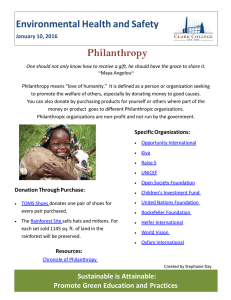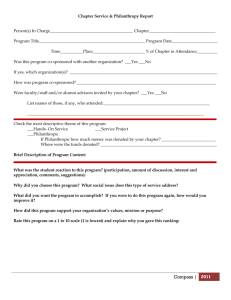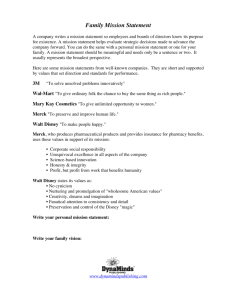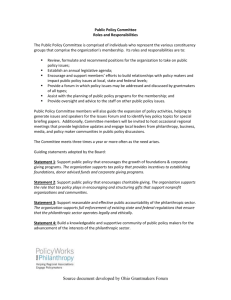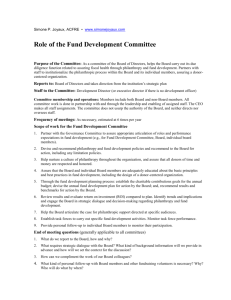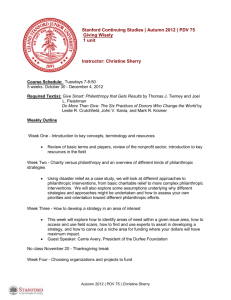Undergraduate, graduate, and extended programs
advertisement
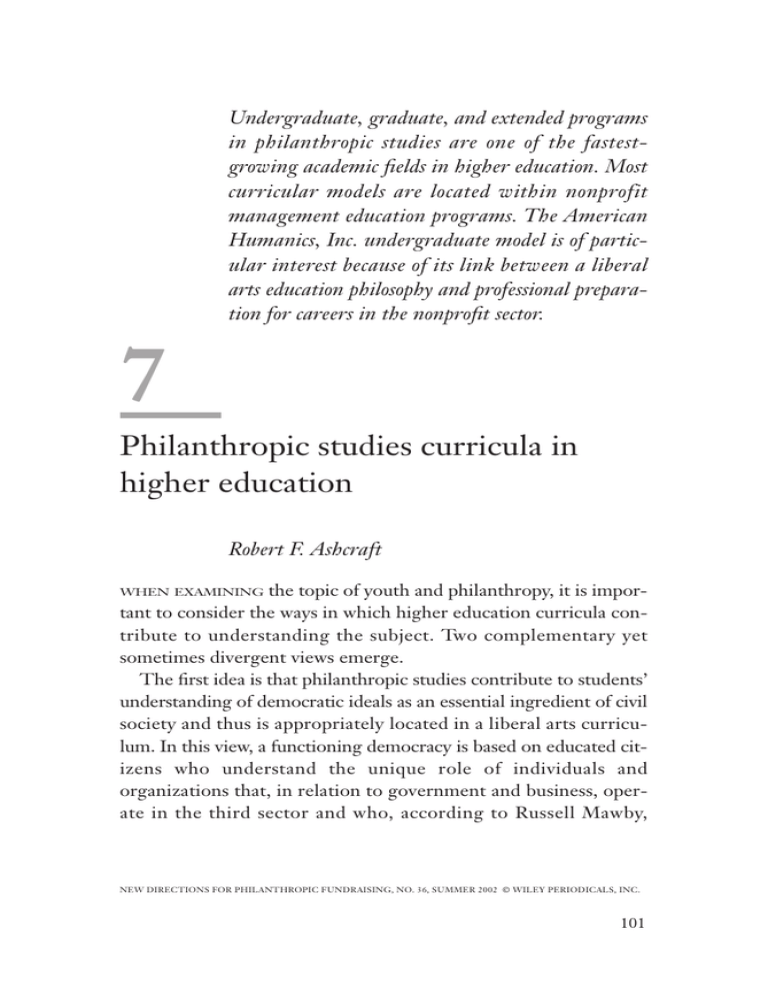
Undergraduate, graduate, and extended programs in philanthropic studies are one of the fastestgrowing academic fields in higher education. Most curricular models are located within nonprofit management education programs. The American Humanics, Inc. undergraduate model is of particular interest because of its link between a liberal arts education philosophy and professional preparation for careers in the nonprofit sector. 7 Philanthropic studies curricula in higher education Robert F. Ashcraft the topic of youth and philanthropy, it is important to consider the ways in which higher education curricula contribute to understanding the subject. Two complementary yet sometimes divergent views emerge. The first idea is that philanthropic studies contribute to students’ understanding of democratic ideals as an essential ingredient of civil society and thus is appropriately located in a liberal arts curriculum. In this view, a functioning democracy is based on educated citizens who understand the unique role of individuals and organizations that, in relation to government and business, operate in the third sector and who, according to Russell Mawby, WHEN EXAMINING NEW DIRECTIONS FOR PHILANTHROPIC FUNDRAISING, NO. 36, SUMMER 2002 © WILEY PERIODICALS, INC. 101 102 CREATING TOMORROW’S PHILANTHROPISTS “provide much of the quality and character of life at the community level” (Mawby, 2002, p. 2). The second idea is that philanthropic studies meets the needs of an emerging nonprofit sector workforce and is appropriately embedded within nonprofit leadership and management education programs for the benefit of students who desire salaried positions in nonprofit organizations. In this view, understanding the historical context of philanthropy in American society and learning the techniques associated with fundraising, volunteer management, fiscal management, and other skills contribute to the efficient and effective operation of nonprofit organizations by practitioners specifically prepared for a profession of service. The purpose of this chapter is to examine philanthropic studies within university-based curricula without debating the relative merits of either viewpoint. First, as a means for understanding this topic, a rationale for nonprofit management education is offered that provides a context for higher education approaches to the subject matter. Next, a brief overview of nonprofit leadership and management education offerings, with an emphasis on graduate programs, is discussed as a means by which philanthropic curricula can be formally identified and examined. This is an appropriate strategy, given the enormous growth of nonprofit leadership and management programs in the past two decades and the availability of data that reveal characteristics of such offerings. Then a particular undergraduate curricular model promulgated by American Humanics, Inc. (AH) that describes the integration of a liberal arts education philosophy with that of an applied, professional practice approach to workforce preparation is examined. The AH program has grown dramatically during the past decade in the number of campus affiliates, national nonprofit partners, and collaborating professional organizations, including the AFP. Undergraduate students typically reflect an age demographic more closely related to the youth theme of this journal issue, so AH and its contribution to philanthropic studies is worthy of analysis. Last, consideration is given to the future of philanthropic studies in higher education. PHILANTHROPIC STUDIES CURRICULA 103 Reasons for philanthropic studies and nonprofit management education The growth of nonprofit management education studies can be attributed to a number of trends, but no single factor is likely more important than the growth of the nonprofit sector itself (O’Neill, 2002). Detailed reasons for the growth of this sector are beyond the scope of this chapter. However, some trends are attributed to the increased reliance by government on nonprofits to provide human services, an increase in citizen action that uses the nonprofit form to engage in work that advances a cause, and unparalleled economic growth resulting in increased numbers of philanthropic organizations, such as grant-making foundations and philanthropic organizations specializing in social ventures that contribute both time and monies to nonprofits (O’Neill, 2002; Light, 2000). As the nonprofit sector has grown, so too has interest in jobs that employ graduates of nonprofit management education programs. According to Paul Light, “the nonprofit sector has become a destination of choice for graduates of top public policy and administration graduate schools” (Light, 2000, p. 9). Similarly, a growing scholarly field has contributed to an emerging body of knowledge that seeks to understand philanthropy in both broad and specific contexts. In comparison with others, the field of philanthropic studies is still new; it is less than thirty years old. Scholarly organizations such as the Association for Research on Nonprofit Organizations and Voluntary Action (ARNOVA) and the International Society for Third Sector Research (ISTR) are relatively new in form and function, but they do offer important outlets for academics and practitioners who wish to study the field and disseminate research findings. During the past two decades, an explosive growth in the quantity and quality of publications has occurred. The Journal of Nonprofit Management and Leadership, Nonprofit, Voluntary Sector Quarterly, Voluntas, and the Journal of Volunteer Administration are a few examples of publications that have emerged in the field. Periodicals such as the Nonprofit Times, Chronicle of Philanthropy, 104 CREATING TOMORROW’S PHILANTHROPISTS Nonprofit Quarterly, Advancing Philanthropy, and Foundation News and Commentary enjoy growing readership among academics, practitioners, and students of the field. Hundreds of books have been written and disseminated by leading publishers on a range of topics in the field. In addition, foundation, corporate, and individual financial sources have provided resources for the expansion of educational programs. One example is the W. K. Kellogg Foundation’s fiveyear Building Bridges Initiative, begun in 1998. Through this and other grants to dozens of kindred organizations, it has invested more than $15 million in programs that extend the reach of educational programs to students and practitioners, with a primary goal of professionalizing this emerging career field (http://www. centerpointinstitute.org/bridges/). Further, Kellogg has invested more than $2.5 million through American Humanics, Inc. to expand the quantity, quality, and geographic reach of undergraduate programs affiliated with AH. The Kellogg Foundation has adopted a holistic strategy by investing in a range of programs across undergraduate, graduate, and noncredit programs within universities and by providing grants to nonacademic organizations that provide training programs for practitioners. As a result, some universities that had exploratory interest in developing one or more models of nonprofit management education were able to compete for start-up monies to develop courses and recruit students. Michael O’Neill and Dennis Young are two scholars who note that the development of nonprofit management education has likely occurred, in part, because of the theory that there are significant differences between organizational realities of nonprofit organizations versus those in business or the public sectors (O’Neill and Fletcher, 1998; Young, 1998). When considering management components involving fundraising, volunteerism, and governance issues of nonprofits, it is not surprising that many colleges and universities have developed new courses to meet the demand for such topics. Also a growing number of academic associations are paying attention to the growth of nonprofit management education pro- PHILANTHROPIC STUDIES CURRICULA 105 grams. The American Assembly of Collegiate Schools of Business (AACSB) and the National Association of Public Affairs and Administration (NASPA) are two bodies that contribute to the national dialogue about potential accreditation of nonprofit management education programs. Though formal accreditation of philanthropic studies or nonprofit management education programs does not currently exist, the efforts of NASPA have resulted in a graduate program curriculum template that offers a thorough guide for developing a curriculum for this field of study (http://www. naspaa.org/guidelines/guide_npft.htm). Last, a growing number of nonprofit academic centers have been created on university campuses during the past two decades. The Nonprofit Academic Centers Council (NACC) has emerged as an organization of thirty-eight center directors who exchange information and provide mutual support for a range of research, education, and outreach activities (http://www.independentsector. org/nacc/). The NACC organization is also developing standards for undergraduate, graduate, executive education, and noncredit or extended education curricula in the field. Philanthropic studies in the curriculum It is not possible to identify all the places within higher education where the study of philanthropy occurs. Literature of the field is found across disciplines such as history, economics, political science, philosophy, religious studies, public administration, business management, law, social work, recreation, sociology, and anthropology. It also is not clear to what extent the topic of philanthropy is actually more or less introduced during the extracurricular or cocurricular activities in which students engage during their collegiate years. For example, the growth of service-learning initiatives and the promulgation of student development programs associated with campus service clubs, fraternities, and sororities, as well as similar out-of-classroom experiences, help shape students’ understanding of the role of philanthropy in American society. Frequently, 106 CREATING TOMORROW’S PHILANTHROPISTS through the engagement of students in service and activities sometimes labeled “charity” work, students learn to extend beyond the reach of the classroom, and it is supposed that ideas are shaped and perceptions formed by such philanthropic activities. Most common are philanthropy curricula found within the rapidly expanding nonprofit management education programs. Throughout the decade of the 1990s, researchers from Seton Hall University—Naomi Wish and Roseanne Mirabella—have tracked this growth. They note 242 institutions offering one or more undergraduate, graduate, or noncredit courses in this emerging field of study (http://pirate.shu.edu/~mirabero/). The Wish and Mirabella studies also reveal that academic programs specifically called philanthropic studies are not readily identifiable in higher education. It is evident that although many programs have concentrations in the fields, they typically use a name like “nonprofit studies” and so are not revealed when the “philanthropic studies” term in an Internet search engine is used. In fact, only Indiana University was noted as using the name in the title of their program that leads to a Master of Arts degree in philanthropic studies (Mirabella and Wish, 2001). Increasingly, institutions are identifying philanthropic studies as an emphasis or certificate option within a degree program. For example, Ferris State University, located in Grand Rapids, Michigan, offers a new master’s degree in education (MEd) with a concentration in philanthropy and a postbaccalaureate certificate option in philanthropic studies. Despite the lack of specific degrees and certificates that are named for philanthropic studies, it is unlikely that a student could graduate from any undergraduate or graduate degree program without at least some exposure, however minimal, to the philanthropic studies field. In their early research efforts, Wish and Mirabella found that in 1990, seventeen universities offered a graduate concentration (three or more courses) in nonprofit management. By 1992, the number had grown to thirty-two with such programs, and by 1996 nearly eighty colleges and universities offered nonprofit management education programs. In their most recent study, Mirabella and Wish PHILANTHROPIC STUDIES CURRICULA 107 (2001) identified ninety-one colleges and universities offering either a graduate degree or a concentration (three or more courses) in the field of study. Further, they identified an additional forty-six higher education institutions that offered at least one or two graduate courses (see Table 7.1). When considering the growth of undergraduate programs, particularly those affiliated with American Humanics and the continuing education noncredit models offered in a variety of locations, it is clear that nonprofit management education is one of the most rapidly growing fields of study in higher education. Upon examining the content of such curricular offerings, Mirabella and Wish (2001) note that both the theory and practice of philanthropy are frequently taught. For example, most programs treat the history of philanthropy and the nonprofit sector as a means by which philanthropic behavior, motives, and organizational structures are understood. At the same time, the skills associated with fundraising, as well as the ethical concerns that face the practitioner, are frequently considered, thus at times embedding the theoretical and practical into the same program. As noted by Wish (1998), “these programs provide instruction not only on how to ‘do good’ but also how to do it well” (p. 45). Institutions offer an array of curricular choices, ranging from those offering just one or two courses, to those with an identified emphasis area, to others offering a transcript-recognized certificate. A relatively few but growing number of universities are offering fully developed degrees in the field, along with certificate options in such areas as fundraising, arts management, and philanthropic studies. Table 7.1. Undergraduate, Graduate, and Noncredit Courses in Nonprofit Management Universities offering courses in nonprofit management Universities offering noncredit courses Universities offering noncredit courses affiliated with continuing education Universities offering undergraduate credit courses in nonprofit management 242 66 53 83 108 CREATING TOMORROW’S PHILANTHROPISTS When considering the academic home of graduate programs in nonprofit management education programs, it is evident that the majority of such curricula (44 percent) reside within programs, departments, schools, or colleges of public administration. This is not entirely surprising, given that leaders prepared for public service often share similar characteristics to those found in nonprofit organizations. Increasingly however, such programs are found in other disciplines (43 percent) such as social work, interdisciplinary studies, and even recreation. Colleges of business comprise approximately 7 percent of nonprofit management education programs. The Mirabella and Wish (2001) studies show that as the number of nonprofit management degrees has increased in quantity and geographic reach, nearly half (47 percent) are offered as a concentration inside a master’s degree in public administration (MPA), with the remaining distribution noted in Table 7.2. Courses in nonprofit management education programs tend to cluster around seven major themes (Mirabella and Wish, 2001). These include • • • • • • • Philanthropy and the third sector Advocacy, public policy, and community organizing Fundraising, marketing, and public relations Nonprofit management skills Financial management, finance, and accounting Human resource management Boundary-spanning courses Table 7.2. Location of Graduate Program Degrees or Concentrations in Nonprofit Management Master of Public Administration (MPA) degrees Master of Business Administration degrees Master of Science (MS) degrees Master of Social Work (MSW) degrees Master of Arts (MA) degrees Other master’s degrees (for example, Master of Nonprofit Management) 47% 6% 10% 17% 11% 9% PHILANTHROPIC STUDIES CURRICULA 109 Of particular interest to students involved in learning about philanthropy is the first identified topic: Philanthropy and the Third Sector. Through these courses, students learn about the history of philanthropy and the nonprofit sector, the size and scope of the third sector, and motives and values behind philanthropic behavior. It is important to note that not every nonprofit management education program provides all content categories. However, the institutions offering full degrees in the field of study can readily identify places in their curriculum where each of the content areas is taught. American Humanics model No greater evidence of the explosive growth of nonprofit management education programs exists than in the example of American Humanics (AH) and its network of campus affiliates. The AH program offers insight into a specific undergraduate curricular model that reveals the vestiges of a liberal arts education with that of an applied, professional practice approach to workforce preparation. American Humanics, headquartered in Kansas City, Missouri, is a “strategic alliance of affiliated colleges and universities, national and local nonprofit partners, and collaborating professional organizations . . . all concerned about the growing need for better prepared college graduates as professionals in the nonprofit sector” (American Humanics, 2000, p. 2). H. Roe Bartle, former mayor of Kansas City and long-time executive of the Heart of America Council, Boy Scouts of America, founded American Humanics in 1948. In the early years of the organization, campus affiliates were few in number, and the majority of graduates were employed in scouting or other youth-serving organizations. In the past two decades, however, AH expanded its geographic reach across the nation, and its educational programs changed from youth-agency administration to nonprofit management education. The organization has as its goal “to be the nation’s preferred source of youth and human service nonprofit professionals” (American Humanics, 2001). 110 CREATING TOMORROW’S PHILANTHROPISTS A detailed history of AH and the extent of its offerings are beyond the scope of this chapter, and those interested are encouraged to review published papers that address this topic in detail (see Ashcraft, 2001; Dolch, Kidwell, Sadow, and Smith, 1998). However, it is important to note that the organization grew from a philosophy of education developed in the 1800s at Springfield College in Massachusetts. From this genesis, “humanics” has been interpreted as “the education of the whole person—body, mind and spirit, in the service of humanity” (Ross, 1985, p. 4). Further, the American Humanics framework that permeates Springfield’s educational philosophy is “the education of the total person—the spirit, the mind, the body—with motivation of service to humanity that is international, intercultural, interracial” (Potter, 1989, p. 102). This is not surprising, given its founding as a YMCA training school. The AH program has grown dramatically during the past decade in the number of campus affiliates, national nonprofit partners, and collaborating professional organizations, including the Association for Fundraising Professionals, and its contributions to philanthropic studies are worthy of analysis. Although AH markets its program under the rubric “nonprofit management education” rather than “philanthropic studies,” it is clear that the program bridges these complementary themes and prepares students for careers of service. The American Humanics alliance consists of three distinctive yet complementary entities. First is the National Nonprofit Partners, consisting of eighteen organizations with geographically disbursed local affiliates across the nation (http://www.humanics.org). These nonprofit partners collaborate with local campus programs and seek to hire graduates from AH-affiliated programs. Second, collaborating professional organizations (CPOs) consist of entities that support the nonprofit sector by setting standards and providing training and other services designed to build the capacity of nonprofits and the individuals who serve the sector. CPOs provide educational materials that support AH campus programs and provide outlets for professional memberships for students upon graduation. Campus Affiliates of American Humanics comprise the third part PHILANTHROPIC STUDIES CURRICULA 111 of the alliance. It is through affiliated academic institutions that AH delivers its curricular and cocurricular educational programs. Campus affiliates represent the depth and breadth of American higher education colleges and universities, with a full range of institutional missions and purposes. Each AH campus affiliate is uniquely organized to reflect its own campus environment and educational culture. However, all affiliates adhere to a competency-based approach to educating students. The educational framework consists of competencies incorporated into curricular and cocurricular offerings that prepare students for careers in nonprofit organizations (American Humanics, 2001). The AH competencies are organized under two main categories: (1) foundations for youth and human services nonprofit management and (2) professional development for youth and human services management. As students pursue the mastery of competencies, AH acknowledges that professional nonprofit practice requires knowledge, skills, and attitudes that can and should be developed, measured, and recognized. Upon successful completion of competencies, qualified AH graduates may earn national AH certification. Foundations competencies are not unique to nonprofit managers but are considered essential to professional success. A total of six categories involving more than forty individual competencies are represented in this grouping. A sampling of these competencies is noted for each of the categories: • Career development and exploration: for example, describing organizations’ mission statements or understanding the nature of work in nonprofits • Communication skills: mastering written and oral communication skills • Employability skills: developing a résumé and mastering job interview or computer skills • Personal attributes: demonstrating initiative, exhibiting responsible behavior, or demonstrating leadership characteristics 112 CREATING TOMORROW’S PHILANTHROPISTS • Historical and philosophical foundations: describing the philanthropic structure of nonprofit organizations • Youth and adult development: demonstrating understanding of the development needs of youth and adults Professional development competencies are specific to nonprofit leadership and management. A total of eight categories involving more than sixty individual competencies are represented in this grouping: • Board or committee development: for example, knowing the purpose and structure of volunteer boards and committees • Fundraising principles and practices: developing fundraising activities that support an agency’s mission, evaluating fundraising effectiveness, analyzing donor motivations, or understanding stewardship responsibilities • Human resource development and supervision: identifying factors that motivate volunteers and paid staff in nonprofits, exhibiting basic knowledge of human resource issues, or exhibiting cultural competency and abilities to manage diversity. • General nonprofit management: using techniques for problem solving, exhibiting ethical behavior, and understanding the importance of advocating and lobbying • Nonprofit accounting and financial management: being able to read and interpret financial statements and explain the importance of reporting mechanisms and requirements • Nonprofit marketing: explaining the importance of a marketing philosophy in a nonprofit agency or developing strategies for obtaining client feedback • Nonprofit program planning: describing the process for developing and implementing new programs or discussing the importance of planning programs that are consistent with community goals and diverse cultural values • Nonprofit risk management: explaining the importance of a working knowledge of nonprofit and employment laws and regula- PHILANTHROPIC STUDIES CURRICULA 113 tions or taking precautions in an effort to minimize personal organizational liability and vulnerability The achievement of these competencies occurs in both inclassroom and out-of-classroom experiences administered by a campus faculty-staff director. Practitioners from the field and other campus faculty-staff members are frequent collaborators in these activities. Approximately two thousand students per year are enrolled in AH programs. Graduates of the program are now found in leadership and management positions in various local and national nonprofit organizations. Although some recent research studies have attempted to measure outcomes of the program, AH has lived largely on the testimony of its graduates. As one example, Lee Franklin, a 1994 alumna of the Missouri Valley College AH program, and a director of Disaster and Emergency Services for the American Red Cross, says the following about her AH experience: “Acquiring the American Humanics competencies taught me the basics of group work, problem-solving, budgeting, and community development; and I like knowing I am well trained. I want to make our community a better place, and AH has given the knowledge and expertise I need to become a nonprofit professional” (American Humanics, 2001, p. 9) Arizona State University program The unit at Arizona State University (ASU), the fifth oldest in the national network, provides a window into the world of American Humanics and, as a result, reveals ways in which college students can learn about philanthropy. Although not every AH campus unit operates like ASU’s program, there are elements that each campus program has in common. Members of Phoenix Rotary Club 100 founded the American Humanics program at Arizona State University (AH-ASU) in 1980. Graduates are now employed by nonprofits throughout the nation, 114 CREATING TOMORROW’S PHILANTHROPISTS and the AH-ASU curricular and cocurricular models have been adopted by a number of campus units. The AH-ASU program is administered through an academic unit called the Department of Recreation Management and Tourism. This organizational placement is not entirely surprising, given the historical connection between the AH-ASU program and the leaders of the Boys’ and Girls’ Clubs, YMCA, and other youthdevelopment organizations who helped organize the program and who hired many graduates of the program in subsequent years. Although nearly half of the AH-ASU students major in recreation management, more than 50 percent of the students pursue degrees in a variety of disciplines, including communication, business, psychology, social work, and others. The AH-ASU program offers a 30-credit-hour emphasis track that is a part of most students’ 120credit-hour baccalaureate degree. To provide insight into ways in which students are educated about philanthropy, a review of curricular and cocurricular features of the AH-ASU program follows. Curricular offerings The AH-ASU program offers several academic courses that comprise the core of the undergraduate nonprofit management program: • Introduction to nonprofit organizations: a survey of the nonprofit sector, its history, and the role of philanthropy in American society • Fundraising: the theory and practice of philanthropy in its many forms and best practices in development • Volunteerism: an overview of voluntary action and volunteer management in the nonprofit sector • Youth and human service workshop: an exploration of issues and topics relevant to nonprofit leadership • Managing nonprofit organizations: a senior-level class offering timely topics pertinent to leading and managing nonprofit organizations PHILANTHROPIC STUDIES CURRICULA 115 Also offered are • American Humanics Management Institute: a national management institute featuring workshops, seminars, and simulations led by nationally and internationally renowned nonprofit leaders • American Humanics Senior Internship: a supervised and guided capstone experience of one full semester immersion in a qualifying 501(c)3 nonprofit organization Cocurricular experiences Cocurricular experiences are activities that are separate from but complement the in-classroom courses. Students engage in service, take field trips to organizations, participate in personal development retreats, and involve themselves in a plethora of leadership development activities designed to develop their competencies for professional service. AH-ASU students amass a minimum of 200 leadership hours across a range of out-of-classroom experiences, prior to their required senior internship experience. Thanks to grants from the Arizona-based Stardust Foundation, an innovative cocurricular feature was added in 1999. Through the Stardust Student Philanthropy Fund, students organize themes for their grant making, determine methods for soliciting and reviewing proposals, plan an allocation process, and establish guidelines for evaluation. The impact of the AH-ASU program on students varies according to the motivations, aspirations, and capabilities of each graduate. Although the primary goal of the program is to prepare entry-level graduates for a nonprofit youth and human services career, it is acknowledged that not every graduate seeks or obtains employment in the sector. Anecdotal evidence based largely on annual alumni surveys suggests, however, that students who pursue other avenues on graduation, such as graduate school, marriage, travel, business, or government jobs, have a heightened awareness of philanthropy and its influence on American society. 116 CREATING TOMORROW’S PHILANTHROPISTS Michelle A. Weber, assistant to the president of INDEPENDENT SECTOR in Washington, D.C. and a 1998 graduate of the AH-ASU program, sums up the impact of AH on her life this way: My American Humanics education is the foundation upon which I am building my career in the nonprofit sector. Through the AH program, I learned theory, practiced its application, served in my first leadership roles, and developed a strong commitment to philanthropy. This combination of knowledge, experience and skill is rare in an emerging nonprofit professional, and it has helped me become an integral part of Independent Sector’s staff. [American Humanics, 2001, p. 9] Future of philanthropic studies The field of philanthropic studies appears to be on a trajectory of growth in the years to come. What remains to be seen is the extent to which the field emerges as a unique and distinctive discipline, rooted in the liberal arts, or whether its growth will continue to be within nonprofit management education programs. Clearly, some academic programs are being organized in direct response to the growing nonprofit leadership and management career field. The American Humanics model is one example of a growing educational enterprise in response to the increased number of entry-level jobs in the nonprofit sector. Nonprofit academic centers involved in graduate programs, research efforts, and technical assistance to nonprofits are also growing in response to the importance placed on philanthropy and the American experience. What emerges will likely involve an interesting myriad of educational offerings and capacity-building activities that honor both the promise of a liberal arts tradition and the workforce preparedness goals of professional programs. References American Humanics. Strategic Plan (Rev. ed.). Kansas City, Mo., American Humanics, 2000. American Humanics, Inc. Certification Competency Requirements Handbook (Rev. ed.). Kansas City, Mo.: American Humanics, 2001. PHILANTHROPIC STUDIES CURRICULA 117 Ashcraft, R. F. “Where Nonprofit Management Meets the Undergraduate Experience: American Humanics After 50 Years.” Public Performance and Management Review, 2001, 25(1), 42–56. Dolch, N. A., Kidwell, R., Sadow, J., and Smith, J. “Nonprofit Undergraduate Education: Delivery Models for Curricula within the American Humanics Program.” In M. O’Neill and K. Fletcher, Nonprofit Management Education: U.S. and World Perspectives. New York: Praeger, 1998. Light, P. Making Nonprofits Work: A Report on the Tides of Nonprofit Management Reform. Washington D.C.: The Brookings Institution, 2000. Mawby, R. G. “Remember . . . Reflect.” For the Common Good: Notes from Learning to Give, 2002, 3(2), 1–2. Mirabella, R. M., and Wish, N. B. “University-Based Educational Programs in the Management of Nonprofit Organizations: An Updated Census of U.S. Programs.” Public Performance and Management Review, 2001, 25(1), 30–41. O’Neill, M. Nonprofit Nation: A New Look at the Third America. San Francisco: Jossey-Bass, 2002. O’Neill, M., and Fletcher, K. Nonprofit Management Education: U.S. and World Perspectives. New York: Praeger, 1998. Potter, D. “Operationalizing Our Humanics Philosophy: The Keystone for a Diverse and Pluralistic Springfield College.” Paper presented at the Annual Humanics Lecture, Springfield College, Mass., Sept. 1989. Ross, J. “A Century of Humanics and Humanism at Springfield College.” Paper presented at the Annual Humanics Lecture, Springfield College, Mass., May 1985. Wish, N. “Degrees for Doing Good.” Foundation News & Commentary, MayJune, 1998, 39(3), 45–48. Wish, N. B., and Mirabella, R. M. “Curriculum Variations in Nonprofit Management Graduate Programs.” Nonprofit Management and Leadership, Fall 1998, 9(1), 99–109. Young, D. R. “Nonprofit Management Studies in the United States: Current Developments and Future Prospects.” Journal of Public Affairs Education, 1998, 5(1), 13–23. ROBERT F. ASHCRAFT is associate professor and director of the Arizona State University Center for Nonprofit Leadership and Management. In that role, he also serves as executive director of ASU’s American Humanics Program.

